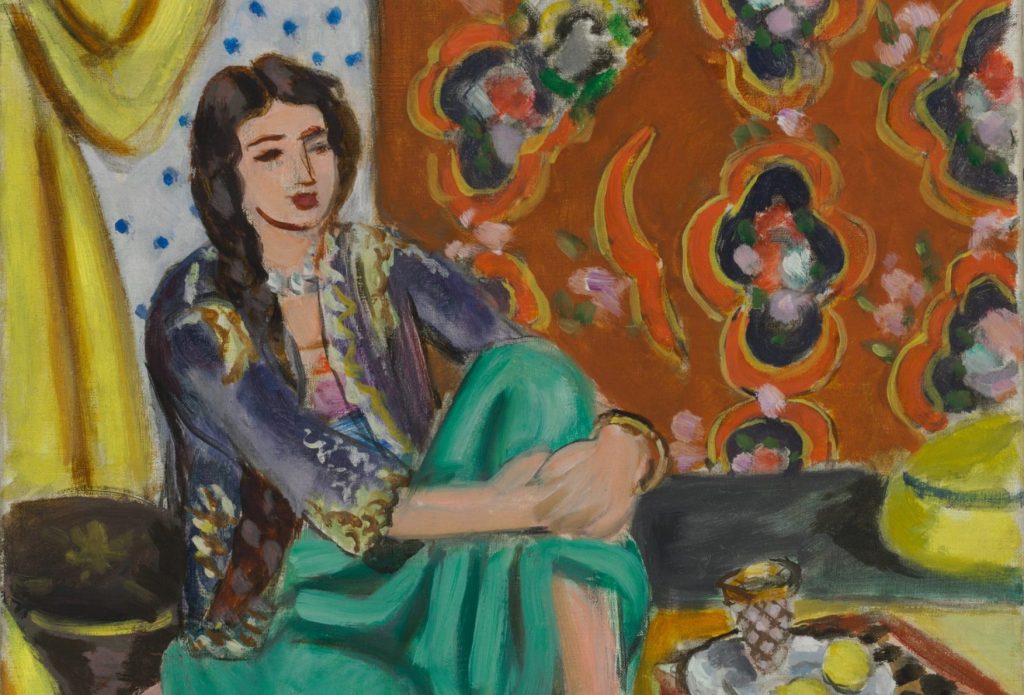French painter Henri Matisse first came into contact with ukiyo-e woodcut prints in the early 20th century, when various world fairs brought Japanese art to Europe. Struggling to get his own career off the ground (his first solo exhibit at Ambroise Vollard’s gallery in 1904 was far from successful), Matisse took a liking to the prints, which offered a whole new way of looking at the world.
As it happens, Matisse’s lifelong fascination with, and indebtedness to, traditional Japanese printmaking is the focus of an exhibition at the Baltimore Museum of Art in Maryland. Titled “The Art of Pattern: Henri Matisse and Japanese Woodcut Artists”, it compares the French Fauvist’s use of color, composition, and pattern to three Japanese printmakers: Kikugawa Eizan, Keisai Eisen, and Utagawa Kunisada.
“There is a clear visual connection between the patterning of Matisse and Japanese woodcut artists of the previous century,” the exhibition’s curators, Katy Rothkopf, director of the Ruth R. Marder Center for Matisse Studies, and Frances Klapthor, associate curator of Asian Art, told Artnet News.
“While Matisse placed his models in staged theatrical settings in his studio, Japanese artists similarly engaged with artifice and illusion, but for different purposes. Their depictions of women conveyed ideals of feminine beauty, exclusivity, and sexual allure, while overt references to known brothels, tea houses, and restaurants were deliberate advertisements.”
The exhibition also highlights stylistic differences related to taste, culture, and history. Where Matisse typically placed his models in an indoor setting, either undressed or in revealing, sensual clothing, Japanese artists generally depicted female figures in public places, wearing elaborately patterned kimonos that commanded as much attention from the viewer as the individuals wearing them.
By contrast, Matisse often saved his patterns for the dreamlike, colorful interiors his subjects inhabited, like in his 1953 oil painting Pink Nude. If Japanese artists, whose work served a commercial as well as artistic purpose, were interested in representing the material reality of their society,Matisse went the opposite route, treating his everyday surroundings as abstract and transcended. Similar visual sensibilities; different outcomes.
“Matisse, who collected textiles and decorative items with patterns throughout his career, found that patterning added depth and interest to his compositions,” Rothkopf and Klapthor explained. “The inclusion of decoration allowed him to dazzle the eye of his viewer, and encouraged a focus on the entire composition rather than just the main subject.”
“The Japanese artists included in ‘The Art of Pattern‘ used ornament and decoration to draw the viewer’s gaze toward their subjects in compelling and seductive ways,” they added. “Unlike the textiles depicted in Matisse’s works, the patterns depicted in the Japanese prints had additional symbolic meanings, which would have been easily discerned by a contemporary Japanese audience.”
Matisse was hardly the only European artist at the turn of the 20th century to take inspiration from Asian art. Painters like Vincent van Gogh and Paul Gauguin were likewise enamored with Japanese woodblock prints, and how different they looked from the western art on which they had been raised and educated. Rather than merely copying the works of Eizan, Eisen, Kunisada, and their contemporaries, Matisse drew on various sources of inspiration to create a style that was all his own, and remains singular to this day.
“The Art of Pattern: Henri Matisse and Japanese Woodcut Artists” runs until January 5, 2025 at the Baltimore Museum of Art, 10 Art Museum Dr, Baltimore, MD 21218.
